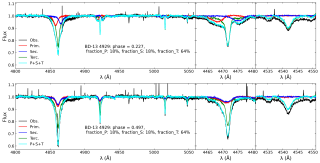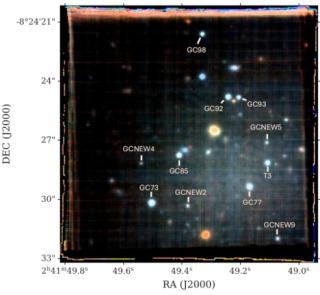We have selected the Galactic HII region M43, a close-by apparently spherical nebula ionized by a single star (HD37061, B0.5V) to investigate several topics of recent interest in the field of HII regions and massive stars. We perform a combined, comprehensive study of the nebula and its ionizing star by using as many observational constraints as possible. For this study we collected a set of high-quality observations, including the optical spectrum of HD3706, along with nebular optical imaging and long-slit spatially resolved spectroscopy. On the one hand, we have carried out a quantitative spectroscopic analysis of the ionizing star from which we have determined the stellar parameters of HD37061 and the total number of ionizing photons emitted by the star; on the other hand, we have done a empirical analysis of the nebular images and spectroscopy from which we have find observational evidence of scattered light from the Huygens region (the brightest part of the Orion nebula) in the M43 region. We show the importance of an adequate correction of this scattered light in both the imagery and spectroscopic observations of M43 in accurately determining the total nebular Halpha luminosity, the nebular physical conditions. and chemical abundances. We have computed total abundances for three of the analyzed elements (O, S, and N), directly from observable ions (no ionization correction factors are needed). The comparison of these abundances with those derived from the spectrum of the Orion nebula indicates the importance of the atomic data and, specially in the case of M42, the considered ionization correction factors.
Advertised on
It may interest you
-
 The most massive stars in the universe are often born and evolve in binary and multiple systems — that is, in pairs or groups bound by their mutual gravity. Understanding how they interact with each other is key to explaining everything from their formation to the impact they have on the galaxies they inhabit. The MONOS project (Multiplicity Of Northern O-type Spectroscopic systems) aims to study these systems in the northern sky, combining spectroscopic observations (which analyze light split into its component colors to measure stellar velocities and physical properties) with photometryAdvertised on
The most massive stars in the universe are often born and evolve in binary and multiple systems — that is, in pairs or groups bound by their mutual gravity. Understanding how they interact with each other is key to explaining everything from their formation to the impact they have on the galaxies they inhabit. The MONOS project (Multiplicity Of Northern O-type Spectroscopic systems) aims to study these systems in the northern sky, combining spectroscopic observations (which analyze light split into its component colors to measure stellar velocities and physical properties) with photometryAdvertised on -
 O ne of the key challenges in astronomy is to measure accurate distances to celestial objects. Knowing distances is crucial since it allows us to measure physical properties such as size, mass and luminosity. Since we can’t go out and use a tape-measure, a range of different approaches have been developed. Many of these approaches rely on using “standard candles”. Standard candles are objects (for example stars or supernovae) for which we know their intrinsic ”true” brightness. Once we know this, then their observed brightness compared to their intrinsic brightness gives us a distance to theAdvertised on
O ne of the key challenges in astronomy is to measure accurate distances to celestial objects. Knowing distances is crucial since it allows us to measure physical properties such as size, mass and luminosity. Since we can’t go out and use a tape-measure, a range of different approaches have been developed. Many of these approaches rely on using “standard candles”. Standard candles are objects (for example stars or supernovae) for which we know their intrinsic ”true” brightness. Once we know this, then their observed brightness compared to their intrinsic brightness gives us a distance to theAdvertised on -
 Understanding the magnetic field in the corona is key for explaining the fascinating physical processes occurring there. However, the extreme conditions in the outer solar atmosphere hamper the possibility of acquiring observations with enough quality to infer the coronal magnetic field. Analyzing observations of overdensities of cold plasma supported by coronal magnetic fields, including filaments and prominences, allows us to understand such magnetic fields and their interaction with plasma. In this study, we have analyzed an active region prominence, a type of prominence that has barelyAdvertised on
Understanding the magnetic field in the corona is key for explaining the fascinating physical processes occurring there. However, the extreme conditions in the outer solar atmosphere hamper the possibility of acquiring observations with enough quality to infer the coronal magnetic field. Analyzing observations of overdensities of cold plasma supported by coronal magnetic fields, including filaments and prominences, allows us to understand such magnetic fields and their interaction with plasma. In this study, we have analyzed an active region prominence, a type of prominence that has barelyAdvertised on